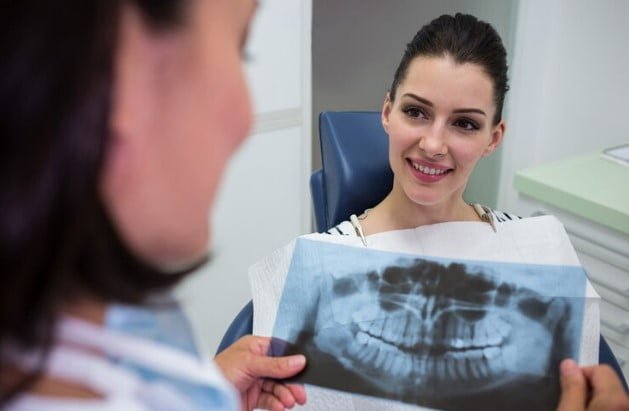
Dental X-rays are a diagnostic tool that dentists use to detect issues that aren’t evident during an average dental exam. By providing precise pictures of your teeth, bones, and soft tissues surrounding them, dental Xrays help in the detection of dental cavities, bone loss abscesses tooth decay or any number of ailments – but the expense could be prohibitive for some patients. We will discuss here what factors impact the cost of dental Xrays; what average costs might look like; as well as common queries so that you can make an informed decision regarding your own dental health!
What Are Dental X-Rays?
Dental X-rays show images of your teeth and bones that are created together. They allow dentists to examine the tooth structure root, jaw structure and facial bone composition. There are a variety of dental X-rays. Each created for specific diagnostic needs:
Types of Dental X-Rays
Bitewing X-Rays:
The purpose of this test is to detect tooth decay and changes in bone density due to gum disease.
Frequency: 6-12 months for periodic check ups.
Periapical X-Rays:
Their goal is to display all aspects of a tooth from crown, root and surrounding bone.
Frequency: Assess the cause of specific issues such as bone loss or abscesses to ensure timely intervention.
Panoramic X-Rays:
Objective: To provide an overall view of all areas within the mouth including jaws, teeth and sinuses.
On average, it should be taken every 2-4 years, unless required to treat specific medical conditions.
Occlusal X-Rays:
The objective is to acquire images of the roof or floor of the mouth in order to search for missing dental teeth, jaw fractures or Cleft palate.
Frequency: As needed in accordance with the patient’s symptoms and dental suggestions.
Cone Beam CT Scans:
Objective: To give 3D images of dental structures Soft tissues, nerve pathways, and bone.
Frequency: Applied to complicated cases such as dental implant planning or orthodontic evaluations.
Factors Impacting the Cost of Dental X-Rays

The price of dental X-rays will depend on different things. Below are a some things to keep in mind when making this decision:
1. Type of X-Ray
Bitewing, periapical and Occlusal X-rays are affordable than panoramic and CT cone beam X-rays.
Panorama and cone beam CT scans give in-depth views, making them essential tools in complex diagnostic procedures.
2. Geographic Location
The cost of dental services such as X-rays and dental cleaning could differ considerably depending on where you reside.
Regions that are urban or have an more cost of living might have higher costs as compared to rural or less wealthy areas.
3. Dental Insurance
Dental insurance plans provide routine X-rays for preventive health care.
Specialized X-rays like cone beam CT scans, could be restricted or may require extra costs out of pocket.
4. Dental Clinic or Provider
The fees can differ between dental clinics and dental providers.
5. Number of X-Rays Needed
The amount of Xrays needed will affect the cost of the procedure.
Many images are often needed to identify and treatment plans for different ailments.
Average Costs of Dental X-Rays
Although prices can differ but here are some typical prices for various types of dental X-rays within the United States:

Bitewing X-Rays
Average Cost: $20 – $50 per image
The typical price for a Full Kit (4 images) from $80 to $200
Periapical X-Rays
Budget: $25 – $50 per image
The typical range for multiple Images (2-4 pictures) from $50-$200
Panoramic X-Rays
Average Cost: $100 to $250
Gives a complete look at the mouth from all angles
Occlusal X-Rays
Average Cost: $20 to $600 per image
For specific diagnostic reasons
Cone Beam CT Scans
Average Cost: $150 to $750
Provides detailed 3D images for complex cases
Understanding Your Dental Insurance Coverage
Dental insurance is a great way to reduce costs for X-rays that are out of your pocket. But, it’s important to be aware of your policy’s coverage requirements. Here are some helpful tips:
1. Review Your Benefits Summary
Review your insurance plan’s benefits overview to find out the kinds of Xrays covered as well as the amount of the coverage.
Bitwings and other preventive X-rays are usually covered completely.
2. Networks in-network and. Out-of-Network Providers
Visiting providers in-network will benefit you maximize your benefits and cut cost.
In the event of out-of-network providers, it could cause higher out-of-pocket costs.
Contact your service provider to warrant all required approvals are in the correct order.
Frequently Asked Questions
Are the Advantages of Dental X-Rays?
Dental X-rays check issues which cannot be seen on an ordinary eye such as gum disease, cavities and bone loss. Their checking capabilities and treatment plans play an important role in giving right diagnoses of oral conditions like gum disease.
Can my dental insurance pay for expenses for an X-ray?
Dental insurance plans typically will cover the cost of routine Xrays as part of reventive treatment. The coverage offered for specific scans can differ. Examine your insurance benefits to know the protection.